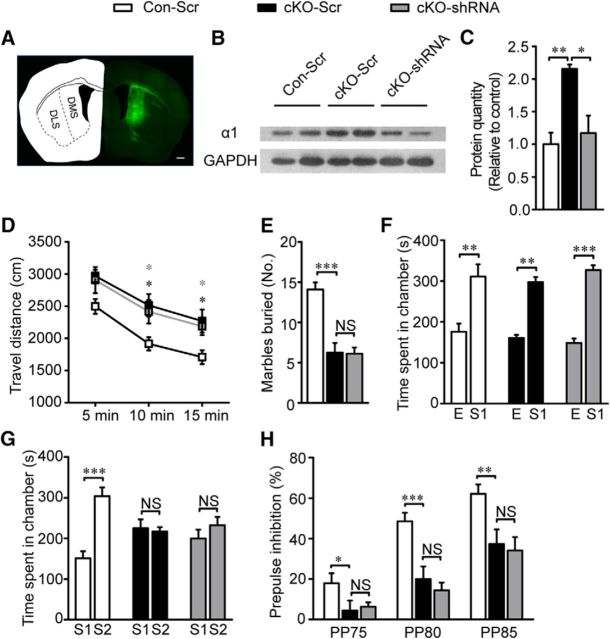Figure 6.
Restoring GABA function specifically in DMS did not rescue behavior deficits. A, GFP expression in cells 3 weeks after virus transfection to DMS (AP + 0.5 mm, ML ± 1.9 mm and DV + 3.2 mm). Scale bar, 500 μm. B, C, Representative immunoblots and quantification of GABAAR α1 in the CPu of Con-Scr, cKO-Scr, and cKO-shRNA mice (n = 3 Con-Scr, 3 cKO-Scr, and 3 cKO-shRNA). D, Hyperactivity was almost not changed during open-field test in cKO mice after interfering GABAAR α1 expression in DMS (n = 12 Con-Scr, 12 cKO-Scr, and 10 cKO-shRNA). E, Almost equal buried marbles were counted between cKO-Scr and cKO-shRNA (n = 12 Con-Scr, 8 cKO-Scr, and 9 cKO-shRNA). F, Virus injection did not have any effect on social interaction behavior (n = 12 Con-Scr, 8 cKO-Scr, and 9 cKO-shRNA). G, Impaired social novelty recognition did not reverse during three chamber test after restoring GABA function in DMS because both cKO-Scr and cKO-shRNA showed no preference between first and second stranger (n = 12 Con-Scr, 8 cKO-Scr, and 9 cKO-shRNA). H, Similar percentage of PPI between cKO-Scr and cKO-shRNA demonstrated interfering GABAAR α1 expression in DMS did not restore sensorimotor gating function (n = 12 Con-Scr, 8 cKO-Scr, and 9 cKO-shRNA). In the behavior test of the DMS virus injection, the virus expression in one cKO-shRNA mice was not restricted to the DMS and its data were excluded for the behavior analysis. Statistical significance was determined by one-way ANOVA with Bonferroni post hoc test (C, E) or two-way ANOVA with Bonferroni post hoc test (D, F, G, H). All data are shown as mean ± SEM. NS, No significant difference.

